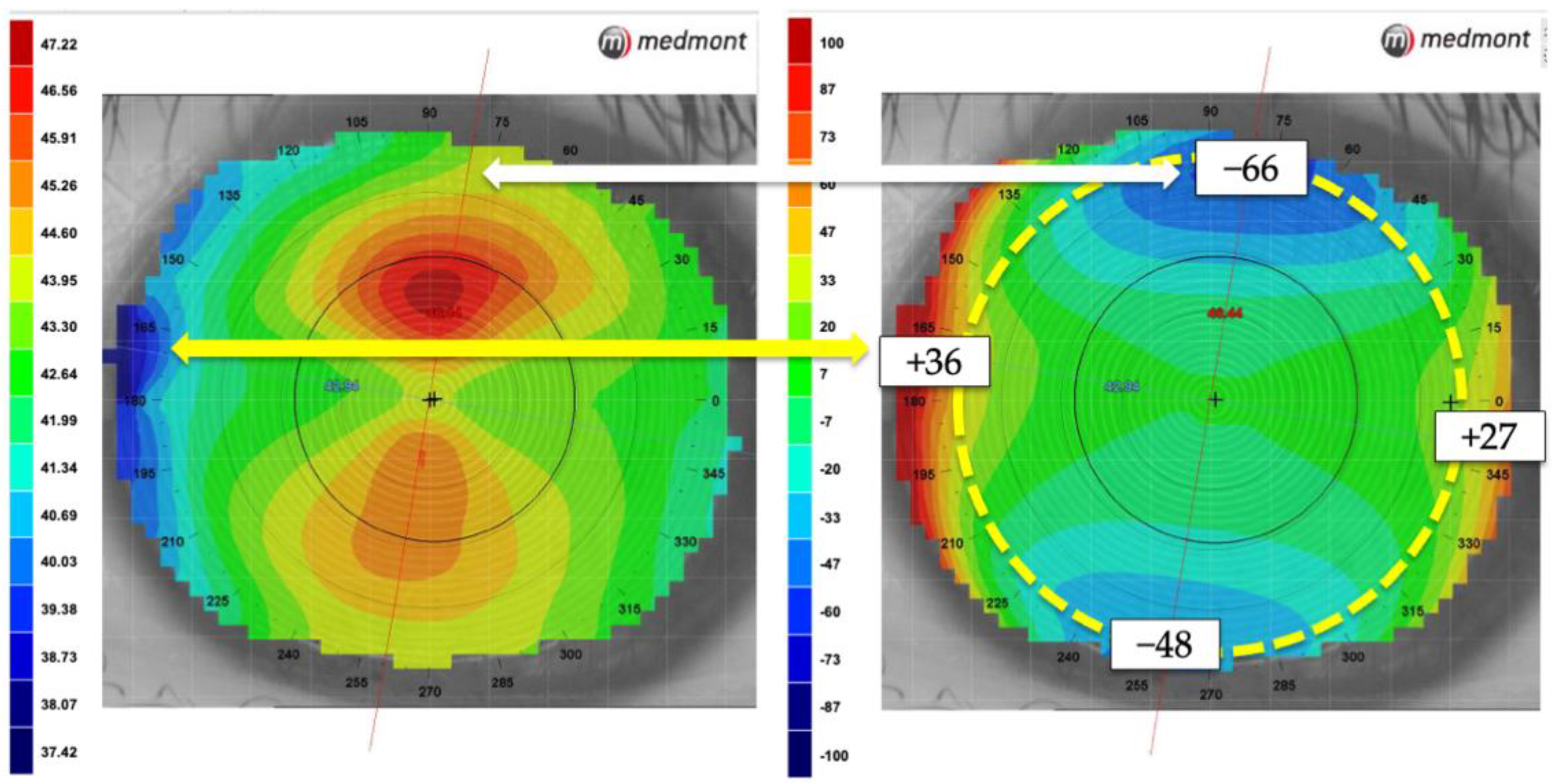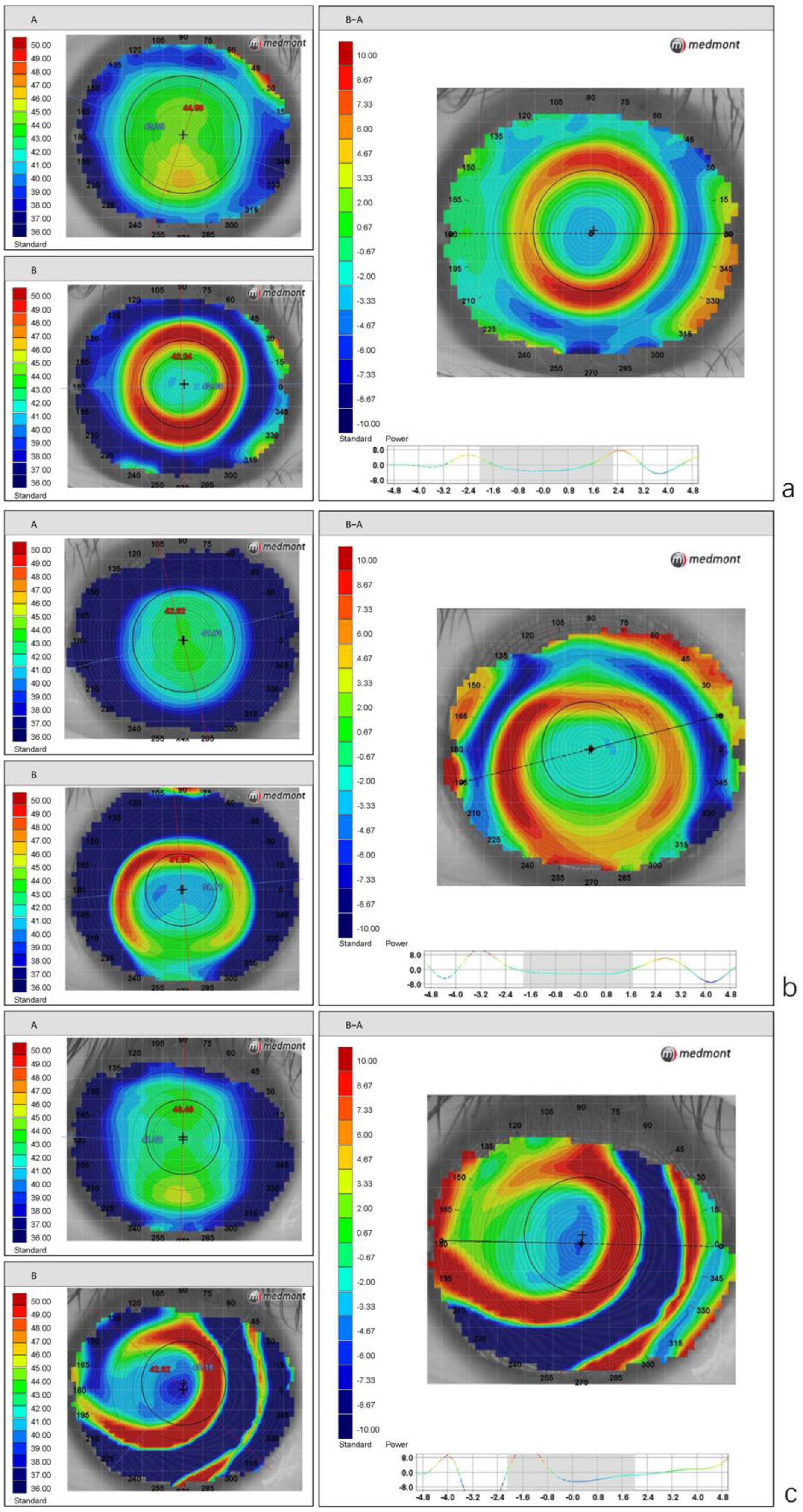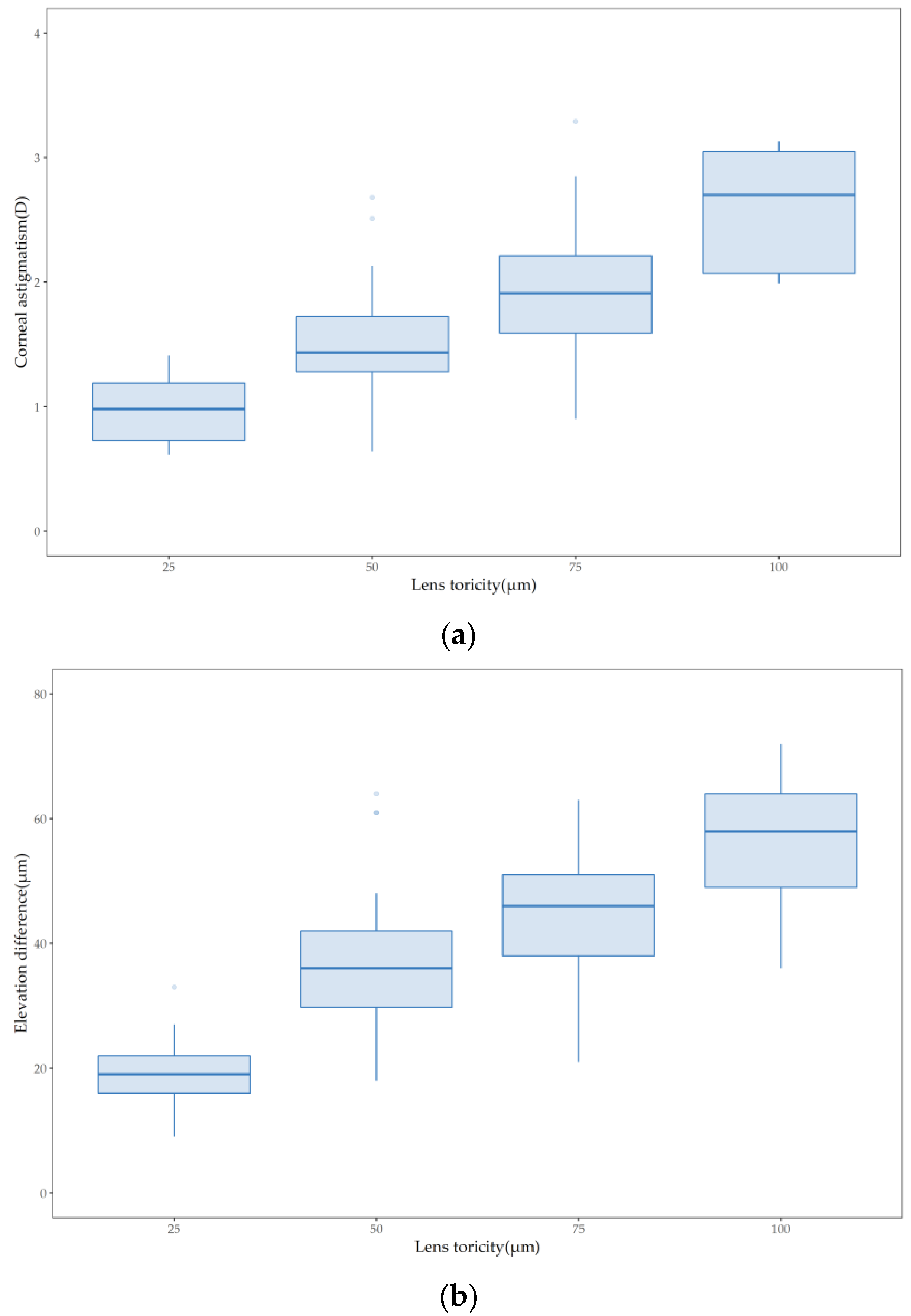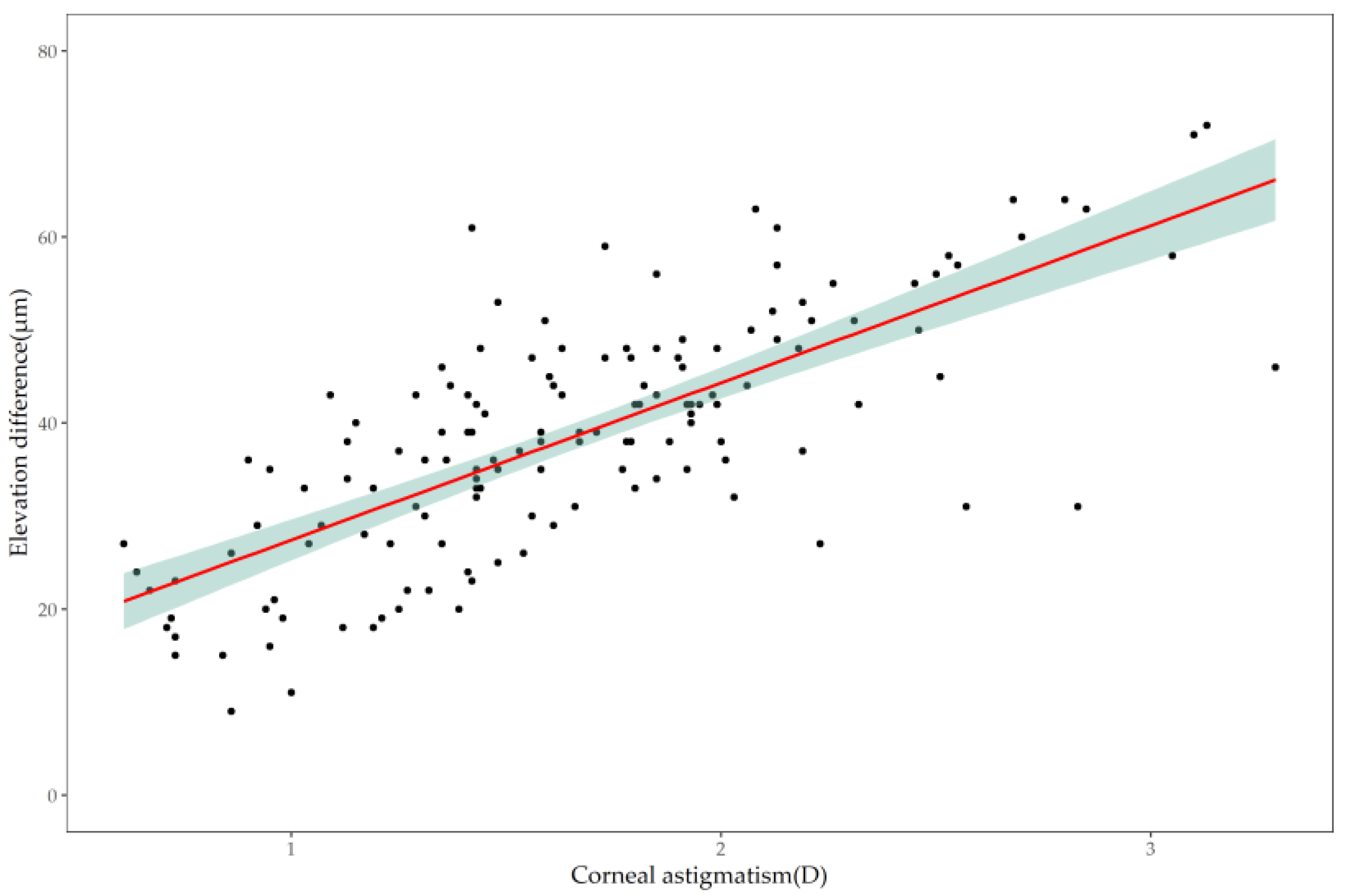To Achieve a Bullseye: Factors Related to Corneal Refractive Therapy Orthokeratology Lens Toricity
Abstract
:1. Introduction
2. Patients and Methods
2.1. Patients
2.2. Refraction
2.3. Orthokeratology Lens
2.4. Examinations before Lens Fitting
2.5. CRT Lens Fitting
2.6. Follow-Up
2.7. Classification of Corneal Topography (Difference Map)
2.8. Statistical Analysis
3. Results
3.1. Demographics
3.2. Multiple Linear Regression Analysis
4. Discussion
Author Contributions
Funding
Institutional Review Board Statement
Informed Consent Statement
Data Availability Statement
Conflicts of Interest
References
- Xiao, O.; Guo, X.; Wang, D.; Jong, M.; Lee, P.Y.; Chen, L.; Morgan, I.G.; Sankaridurg, P.; He, M. Distribution and Severity of Myopic Maculopathy Among Highly Myopic Eyes. Investig. Ophthalmol. Vis. Sci. 2018, 59, 4880–4885. [Google Scholar] [CrossRef] [PubMed]
- Cho, P.; Tan, Q. Myopia and Orthokeratology for Myopia Control. Clin. Exp. Optom. 2019, 102, 364–377. [Google Scholar] [CrossRef] [PubMed]
- Walline, J.J.; Jones, L.A.; Sinnott, L.T. Corneal Reshaping and Myopia Progression. Br. J. Ophthalmol. 2009, 93, 1181–1185. [Google Scholar] [CrossRef] [PubMed]
- Cho, P.; Cheung, S.W.; Edwards, M. The Longitudinal Orthokeratology Research in Children (LORIC) in Hong Kong: A Pilot Study on Refractive Changes and Myopic Control. Curr. Eye Res. 2005, 30, 71–80. [Google Scholar] [CrossRef] [PubMed]
- Kakita, T.; Hiraoka, T.; Oshika, T. Influence of Overnight Orthokeratology on Axial Elongation in Childhood Myopia. Invest. Ophthalmol. Vis. Sci. 2011, 52, 2170–2174. [Google Scholar] [CrossRef] [PubMed]
- Cho, P.; Cheung, S.W. Retardation of Myopia in Orthokeratology (ROMIO) Study: A 2-Year Randomized Clinical Trial. Investig. Ophthalmol. Vis. Sci. 2012, 53, 7077–7085. [Google Scholar] [CrossRef] [PubMed]
- Santodomingo-Rubido, J.; Villa-Collar, C.; Gilmartin, B.; Gutiérrez-Ortega, R.; Sugimoto, K. Long-term Efficacy of Orthokeratology Contact Lens Wear in Controlling the Progression of Childhood Myopia. Curr. Eye Res. 2017, 42, 713–720. [Google Scholar] [CrossRef] [PubMed]
- Swarbrick, H.A.; Alharbi, A.; Watt, K.; Lum, E.; Kang, P. Myopia Control during Orthokeratology Lens Wear in Children Using a Novel Study Design. Ophthalmology 2015, 122, 620–630. [Google Scholar] [CrossRef] [PubMed]
- Koffler, B.H.; Smith, V.M. Myopia Reduction Using Corneal Refractive Therapy Contact Lenses. Eye Contact Lens. 2004, 30, 223–226. [Google Scholar] [CrossRef] [PubMed]
- Yang, L.N.; Zhou, J.L.; Xie, P.Y. Toric Design Orthokeratology Contact Lenses and Visual Quality. Chin. J. Optom. Ophthalmol. Vis. Sci. 2013, 15, 79–83. [Google Scholar] [CrossRef]
- Zhang, Y.; Chen, Y.G. Comparison of Myopia Control Between Toric and Spherical Periphery Design Orthokeratology in Myopic Children with Moderate-to-High Corneal Astigmatism. Int. J. Ophthalmol. 2018, 11, 650–655. [Google Scholar] [CrossRef] [PubMed]
- Jiang, J.; Lian, L.; Wang, F.; Zhou, L.; Zhang, X.; Song, E. Comparison of Toric and Spherical Orthokeratology Lenses in Patients with Astigmatism. J. Ophthalmol. 2019, 2019, 4275269. [Google Scholar] [CrossRef] [PubMed]
- Chen, C.; Cheung, S.W.; Cho, P. Myopia Control Using Toric Orthokeratology (TO-SEE Study). Investig. Ophthalmol. Vis. Sci. 2013, 54, 6510–6517. [Google Scholar] [CrossRef] [PubMed]
- Pauné, J.; Cardona, G.; Quevedo, L. Toric Double Tear Reservoir Contact Lens in Orthokeratology for Astigmatism. Eye Contact Lens. 2012, 38, 245–251. [Google Scholar] [CrossRef] [PubMed]
- Chen, Z.; Xue, F.; Zhou, J.; Qu, X.; Zhou, X.; Shanghai Orthokeratology and Study (SOS) Group. Prediction of Orthokeratology Lens Decentration with Corneal Elevation. Optom. Vis. Sci. 2017, 94, 903–907. [Google Scholar] [CrossRef] [PubMed]
- Zhang, Q.T.; Xie, P.Y.; Yang, L.N.; Zhou, J.L. A Machine Learning Model on Orthokeratology Lens Fitting Based on the Data of Optometry Examination. Zhonghua Yan Ke Za Zhi 2019, 55, 105–110. [Google Scholar] [CrossRef] [PubMed]
- Cai, X.; Chen, Y.; Li, Q.; Ma, H.; Tang, Z.; Nie, C.; Lu, R. Anthropometric Analysis on the Ocular Region Morphology of Children and Young Adults in Chinese Han Population. Ophthalmic Plast. Reconstr. Surg. 2019, 35, 326–332. [Google Scholar] [CrossRef] [PubMed]
- Tomiyama, E.S.; Logan, A.K.; Richdale, K. Corneal Elevation, Power, and Astigmatism to Assess Toric Orthokeratology Lenses in Moderate-to-High Astigmats. Eye Contact Lens. 2021, 47, 86–90. [Google Scholar] [CrossRef] [PubMed]
- Wang, Z.; Huang, D.; Chen, X.; Zhu, H.; Sun, Q.; Wang, Y.; Zhang, X.; Wang, Y.; Zhai, L.; Wang, C.; et al. Preschool Children Exhibit Evident Compensatory Role of Internal Astigmatism in Distribution of Astigmatism: The Nanjing Eye Study. Investig. Ophthalmol. Vis. Sci. 2019, 60, 73–81. [Google Scholar] [CrossRef] [PubMed]
- Liu, Y.; Cheng, Y.; Zhang, Y.; Zhang, L.; Zhao, M.; Wang, K. Evaluating Internal and Ocular Residual Astigmatism in Chinese Myopic Children. Jpn. J. Ophthalmol. 2017, 61, 494–504. [Google Scholar] [CrossRef] [PubMed]




| Parameter | Minimum | Maximum | Mean/Median | SD/IQR |
|---|---|---|---|---|
| Spherical degree (D) | −4.00 | −0.50 | −2.66 | 0.92 |
| Cylindrical degree (D) | −1.50 | 0.00 | −0.78 | 0.52 |
| Spherical equivalent (D) | −4.88 | −1.00 | −3.05 | 0.97 |
| Flat keratometry (D) | 39.11 | 45.84 | 42.87 | 1.24 |
| Flat eccentricity | 0.46 | 0.85 | 0.65 | 0.08 |
| Steep eccentricity | 0.05 | 0.82 | 0.45 | 0.16 |
| Corneal astigmatism (D) | 0.61 | 3.29 | 1.66 | 0.57 |
| Average elevation difference at 8 mm chord length (μm) | 9 | 72 | 39 | 13 |
| Lens toricity (μm) | 25 | 100 | 50 | 25 |
| Parameter | r | p |
|---|---|---|
| Flat keratometry (D) | 0.011 | 0.893 |
| Flat eccentricity | 0.159 | 0.057 |
| Steep eccentricity | 0.074 | 0.382 |
| Corneal astigmatism (D) | 0.657 | <0.001 |
| Average elevation difference at 8 mm chord length (μm) | 0.643 | <0.001 |
| Parameter | Unstandardized Beta (β) Coefficients | Standardized Regression Coefficients | t | p |
|---|---|---|---|---|
| Flat keratometry (D) | 0.157 | 0.01 | 0.167 | 0.868 |
| Flat eccentricity | −2.945 | −0.011 | −0.141 | 0.888 |
| Steep eccentricity | 7.745 | 0.063 | 0.679 | 0.498 |
| Corneal astigmatism (D) | 10.913 | 0.319 | 3.012 | 0.003 |
| Average elevation difference at 8 mm chord length (μm) | 0.681 | 0.453 | 4.049 | <0.001 |
Publisher’s Note: MDPI stays neutral with regard to jurisdictional claims in published maps and institutional affiliations. |
© 2022 by the authors. Licensee MDPI, Basel, Switzerland. This article is an open access article distributed under the terms and conditions of the Creative Commons Attribution (CC BY) license (https://creativecommons.org/licenses/by/4.0/).
Share and Cite
Li, C.; Zeng, L.; Zhou, J.; Wang, B.; Chen, Z. To Achieve a Bullseye: Factors Related to Corneal Refractive Therapy Orthokeratology Lens Toricity. J. Clin. Med. 2022, 11, 5635. https://doi.org/10.3390/jcm11195635
Li C, Zeng L, Zhou J, Wang B, Chen Z. To Achieve a Bullseye: Factors Related to Corneal Refractive Therapy Orthokeratology Lens Toricity. Journal of Clinical Medicine. 2022; 11(19):5635. https://doi.org/10.3390/jcm11195635
Chicago/Turabian StyleLi, Changfei, Li Zeng, Jiaqi Zhou, Bingjie Wang, and Zhi Chen. 2022. "To Achieve a Bullseye: Factors Related to Corneal Refractive Therapy Orthokeratology Lens Toricity" Journal of Clinical Medicine 11, no. 19: 5635. https://doi.org/10.3390/jcm11195635
APA StyleLi, C., Zeng, L., Zhou, J., Wang, B., & Chen, Z. (2022). To Achieve a Bullseye: Factors Related to Corneal Refractive Therapy Orthokeratology Lens Toricity. Journal of Clinical Medicine, 11(19), 5635. https://doi.org/10.3390/jcm11195635





